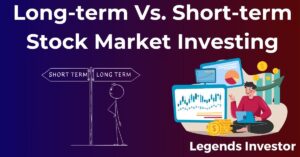Understanding Stock Market Volatility
Definition of Stock Market Volatility
Stock market volatility refers to the rate at which stock prices fluctuate over a given period. It reflects the degree of variation in prices and is often used as a measure of market uncertainty. High volatility indicates significant price swings, while low volatility suggests more stable markets.
How Volatility is Measured
Volatility is commonly measured using statistical tools such as:
- Standard Deviation: Measures the dispersion of stock returns from their average value.
- Beta: Compares the volatility of an individual stock to the overall market.
- Volatility Index (VIX): Often referred to as the “fear gauge,” it measures market expectations of future volatility based on S&P 500 options.
Historical Examples of Volatile Market Periods
- The Great Depression (1929): A period of extreme market swings that affected global economies.
- Black Monday (1987): The Dow Jones Industrial Average dropped by 22.6% in a single day.
- The 2008 Financial Crisis: Marked by sharp declines and unpredictable market movements.
- The COVID-19 Pandemic (2020): Triggered rapid fluctuations due to economic uncertainty.
The Impact of Volatility on Investment Portfolios
Short-Term vs. Long-Term Investment Strategies
- Short-Term: High volatility can create opportunities for day traders but increases risk.
- Long-Term: Investors often ride out market swings, focusing on historical growth trends.
Volatility’s Effect on Portfolio Diversification
Diversification reduces risk by spreading investments across various assets. However, during high volatility, correlations between asset classes may increase, diminishing the benefits of diversification.
The Role of Asset Allocation During Volatile Times
Adjusting asset allocation based on risk tolerance can help mitigate the impact of volatility. For example, shifting towards bonds or cash during turbulent times can preserve capital.
Volatility Indicators and What They Tell Investors
Key Volatility Indices Like the VIX
The VIX measures expected market volatility over the next 30 days. A high VIX indicates fear and uncertainty, while a low VIX suggests stability.
Reading Market Signals and Volatility Indicators
- Moving Averages: Identify trends by smoothing out price data.
- Relative Strength Index (RSI): Measures overbought or oversold conditions.
- Bollinger Bands: Reflect price volatility and potential price reversals.
How to Interpret Volatility for Investment Decisions
Understanding volatility helps investors gauge market sentiment and make informed decisions about buying, holding, or selling.
The Psychology of Investing in Fluctuating Markets
Emotional Reaction to Market Swings
Volatility can trigger fear and greed, leading to impulsive decisions like panic selling or overbuying.
Cognitive Biases Affecting Investment Choices
- Confirmation Bias: Seeking information that supports pre-existing beliefs.
- Loss Aversion: Focusing more on avoiding losses than achieving gains.
Tips for Staying Rational Amid Volatility
- Stick to your investment plan.
- Avoid frequent portfolio checks.
- Focus on long-term goals rather than short-term fluctuations.
Risk Management Techniques for Volatile Markets
Setting Stop-Loss Orders
Stop-loss orders automatically sell a stock when it reaches a specific price, limiting potential losses.
Diversification and Its Limits
While diversification reduces risk, it cannot eliminate losses during market-wide downturns.
Using Hedging as a Protective Strategy
Hedging involves using financial instruments like options or futures to offset potential losses.
Timing the Market vs. Time in the Market
The Challenges of Timing the Market
Attempting to predict market movements is difficult and often results in missed opportunities.
Benefits of a Long-Term Investment Approach
Long-term investing leverages the power of compounding and reduces the impact of short-term volatility.
Historical Data on Market Timing Success Rates
Studies show that staying invested consistently outperforms attempts to time the market.
How to Adjust Your Investment Strategy During High Volatility
Rebalancing Your Portfolio
Regular rebalancing ensures that your portfolio aligns with your risk tolerance and investment goals.
Seeking Advice from Financial Experts
Professional advisors can provide insights and strategies tailored to volatile market conditions.
When to Hold, Sell, or Buy More
Evaluate individual stock performance, market trends, and your financial goals before making decisions.
The Role of Alternative Investments During Market Swings
Exploring Options Like Real Estate or Commodities
Alternative investments often provide stability during volatile periods due to their lower correlation with stocks.
The Advantages of Non-Correlated Assets
Assets like gold or treasury bonds can act as safe havens during market turbulence.
Considering Cryptocurrencies and Their Volatility
Cryptocurrencies offer high potential returns but come with extreme volatility. They require careful risk management.
Maintaining Perspective: Historical Views on Volatility and Growth
Long-Term Trends in the Stock Market
Despite periods of high volatility, the stock market has historically trended upward over the long term.
Recovery Periods After Market Downturns
Markets often recover from downturns, rewarding patient investors who stay invested.
Maintaining Investment Discipline Over Time
Sticking to a well-thought-out investment plan helps weather market volatility and achieve financial goals.
Conclusion
Stock market volatility is a natural part of investing, presenting both risks and opportunities. By understanding volatility, managing risk, and maintaining a disciplined approach, investors can navigate fluctuating markets effectively and achieve long-term success.



